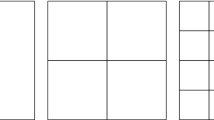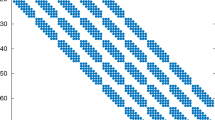Abstract
In this paper, we consider several finite-difference approximations for the three-dimensional biharmonic equation. A symbolic algebra package is utilized to derive a family of finite-difference approximations for the biharmonic equation on a 27 point compact stencil. The unknown solution and its first derivatives are carried as unknowns at selected grid points. This formulation allows us to incorporate the Dirichlet boundary conditions automatically and there is no need to define special formulas near the boundaries, as is the case with the standard discretizations of biharmonic equations. We exhibit the standard second-order, finite-difference approximation that requires 25 grid points. We also exhibit two compact formulations of the 3D biharmonic equations; these compact formulas are defined on a 27 point cubic grid. The fourth-order approximations are used to solve a set of test problems and produce high accuracy numerical solutions. The system of linear equations is solved using a variety of iterative methods. We employ multigrid and preconditioned Krylov iterative methods to solve the system of equations. Test results from two test problems are reported. In these experiments, the multigrid method gives excellent results. The multigrid preconditioning also gives good results using Krylov methods.
Similar content being viewed by others
References
I. Altas, J. Dym, M.M. Gupta and R. Manohar, Multigrid solution of automatically generated high-order discretizations for the biharmonic equation, SIAM J. Sci. Comput. 19 (1998) 1575–1585.
I. Altas and M.M. Gupta, Iterative methods for fixed point problems on high performance computing environment, in: Proceedings of Complex Systems 1996, Albury, Australia, Complex Systems: From Local Interactions to Global Phenomena, eds. R. Sticker, H. Jelinek, B. Durnota and T. Bossomaier (IOS Press, Amsterdam, 1996) pp. 121–128, http://www.csu.edu.au/ci/vol3/altas2/altas2.html
A. Brandt, Multi-level adaptive technique (MLAT) for fast numerical solution of boundary value problems, in: Proc. Third Int. Conf. on Numerical Methods in Fluid Mechanics, Paris, 1972, Lecture Notes in Physics, Vol. 18 (Springer-Verlag, 1973) pp. 82–89.
A. Brandt, Multigrid techniques: 1984 guide with applications to fluid dynamics, in: GMD-Studien Nr. 85 (Gesselschaft für Mathematik und Datenverarbeitung MBH, St. Augustin, 1984).
W. Briggs, A Multigrid Tutorial (SIAM, Philadelphia, 1984).
A.M. Bruaset, A Survey of Preconditioned Iterative Methods(Longman Scientific and Technical, 1995).
L. Bauer and E.L. Riess, Block five diagonal matrices and the fast numerical solution of the biharmonic equation, Math. Comp. 26 (1972) 311–326.
S.D. Conte and R.T. Dames, On an alternating direction method for solving the plate problem with mixed boundary conditions, J. Assoc. Comput. Mach. 7 (1960) 264–273.
R. Freund, A transpose free quasi minimal residual algorithm for non Hermitian linear systems, RIACS technical report 91.18, NASA Ames Research Center, Ames, CA (1991).
R. Freund and N. Nachtigal, QMR: a quasi-minimal residual method for non hermitian linear systems, Numer. Math. 60 (1991) 315–339.
R. Glowinski and O. Pironneau, Numerical methods for the first biharmonic equations and for the two-dimensional Stokes problem, SIAM Rev. 21 (1979) 167–212.
M.M. Gupta, Discretization error estimates for certain splitting procedures for solving first biharmonic boundary value problems, SIAM J. Numer. Anal. 12 (1975) 364–377.
M.M. Gupta, Spectrum transformation methods for divergent iterations, NASA technical memorandum 103745, ICOMP-91-02, NASA Lewis Research Center, Cleveland, OH (1991).
M.M. Gupta and L.W. Ehrlich, Some difference schemes for the biharmonic equation, SIAM J. Numer. Anal. 12 (1975) 773–790.
M.M. Gupta and R. Manohar, Direct solution of biharmonic equation using noncoupled approach, J. Comput. Phys. 33 (1979) 236–248.
Y. Kwon, R. Manohar and J.W. Stephenson, Single cell fourth order methods for the biharmonic equation, Congressus Numerantium 34 (1982) 475–482.
G. Meurant, Computer Solution of Large Linear Systems(North-Holland, 1999).
J. Ribeiro Dos Santos, Équations aux différences finies pour l'équation biharmonique dans l'espace à trois dimensions, C.R. Acad. Sci. Paris Sér. A-B 264 (1967) A291–A293.
Y. Saad, Iterative Methods for Sparse Linear Systems(PWS Publishing Company, 1996).
D.J. Silvester and M.D. Mihajlovic, Efficient preconditioning of the biharmonic equation, Report 362, University of Manchester (2000).
J.W. Stephenson, Single cell discretizations of order two and four for biharmonic problems, J. Comput. Phys. 55 (1984) 65–80.
H. Van der Vorst, BiCGSTAB: a fast and smoothly converging variant of BiCG for the solution of nonsymmetric linear systems, SIAM J. Sci. Comput. 13 (1992) 631–644.
Author information
Authors and Affiliations
Rights and permissions
About this article
Cite this article
Altas, I., Erhel, J. & Gupta, M.M. High Accuracy Solution of Three-Dimensional Biharmonic Equations. Numerical Algorithms 29, 1–19 (2002). https://doi.org/10.1023/A:1014866618680
Issue Date:
DOI: https://doi.org/10.1023/A:1014866618680




